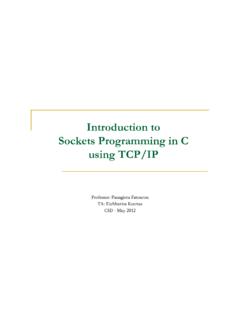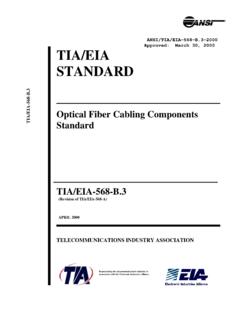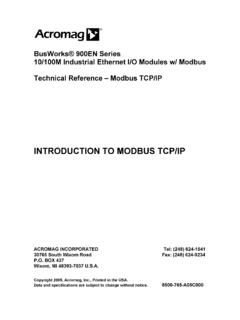Transcription of Introduction to Sockets Programming in C using TCP/IP
1 Introduction to Sockets Programming in C using TCP/IPProfessor: Panagiota FatourouTA: Eleftherios KosmasCSD - May 2012 IntroductionCS556 - Distributed SystemsTutorial by Eleftherios Kosmas 2 computer network hosts, routers, communication channels Hostsrun applications Routersforward information Packets: sequence of bytes contain control information destination host Protocolis an agreement meaning of packets structure and size of Hypertext Transfer Protocol (HTTP)HostRouterCommunication channelProtocol Families - TCP/IPCS556 - Distributed SystemsTutorial by Eleftherios Kosmas 3 Several protocols for different problems)Protocol Suites or Protocol Families: TCP/IP TCP/IP provides end-to-endconnectivity specifying how data should be formatted, addressed, transmitted, routed, and received at the destination can be used in the internet and in stand-alone private networks it is organized into layersTCP/IP* image is taken from * communication ChannelsNetwork Layer IPTransport Layer TCP or UDPFTP, SMTP.
2 CS556 - Distributed SystemsTutorial by Eleftherios Kosmas 4 Internet Protocol (IP) provides a datagramservice packets are handled and delivered independently best-effortprotocol may loose, reorder or duplicate packets each packet must contain an IP address of its destinationCS556 - Distributed SystemsTutorial by Eleftherios Kosmas 5 Addresses - IPv4724 Class A:0 network IDHost ID1416 Class B:1 0 network IDHost ID218 Class C:1 1 0 network IDHost ID28 Class D (multicast):1 1 1 0 Multicast address27 Class E (reserved):1 1 1 to to to to to of addresses The 32bits of an IPv4 address are broken into 4 octets, or 8 bit fields (0-255 value in decimal notation). For networks of different size, the first one (for large networks) to three (for small networks)octets can be used to identify the network , while the rest of the octets can be used to identify the nodeon the -Distributed SystemsTutorial by Eleftherios Kosmas 6 Local Area network Addresses - IPv4CS556 - Distributed SystemsTutorial by Eleftherios Kosmas 7 TCP vs UDP Both use port numbers application-specific construct serving as a communication endpoint 16-bit unsigned integer, thus ranging from 0 to 65535)to provide end-to-end transport UDP: User Datagram Protocol no acknowledgements no retransmissions out of order, duplicates possible connectionless, , app indicates destination for each packet TCP.
3 Transmission Control Protocol reliable byte-stream channel(in order, all arrive, no duplicates) similar to file I/O flow control connection-oriented bidirectionalCS556 - Distributed SystemsTutorial by Eleftherios Kosmas 8 TCP vs UDP TCP is used for services with a large data capacity, and a persistent connection UDP is more commonly used for quick lookups, and single use query-reply actions. Some common examples of TCP and UDP with their default ports:DNS lookupUDP53 FTPTCP21 HTTPTCP80 POP3 TCP110 TelnetTCP23CS556 -Distributed SystemsTutorial by Eleftherios Kosmas 9 Berkley Sockets Universally known as Sockets It is an abstraction through which an application may send and receive data Provide generic accessto interprocesscommunication services IPX/SPX, Appletalk, TCP/IP Standard API for networkingHostApplicationSocketTCPIPHost ApplicationSocketTCPIPR outerIPChannelChannelCS556 -Distributed SystemsTutorial by Eleftherios Kosmas 10 Sockets Uniquely identified by an internet address an end-to-end protocol ( TCP or UDP) a port number Two types of ( TCP/IP ) Sockets Streamsockets ( uses TCP) provide reliable byte-stream service Datagramsockets ( uses UDP) provide best-effort datagram service messages up to bytes Socket extend the convectional UNIX I/O facilities file descriptors for network communication extended the read and write system calls012internal data structure for file 1 Family.
4 PF_INETS ervice: SOCK_STREAML ocal_IP:Remote_IP:Remote_Port:..Local_Po rt: Descriptor TableCS556 -Distributed SystemsTutorial by Eleftherios Kosmas 11 SocketsTCPUDPIP12655351265535 ApplicationsTCP socketsUDP socketsTCP portsUDP portsDescriptor referencesSockets bound to portsCS556 -Distributed SystemsTutorial by Eleftherios Kosmas 12 Socket ProgrammingCS556 - Distributed SystemsTutorial by Eleftherios Kosmas 13 Client-Server communication Server passively waits for and responds to clients passivesocket Client initiates the communication must know the address and the port of the server activesocketCS556 - Distributed SystemsTutorial by Eleftherios Kosmas 14 Sockets -ProceduresCS556 - Distributed SystemsTutorial by Eleftherios Kosmas 15 Client -Server communication -Unixsocket()bind()listen()accept()recv( )send()close()Serversocket()connect()sen d()recv()close()Clientsynchronization pointStream ( TCP)socket()bind()recvfrom()sendto()clos e()Serversocket()sendto()recvfrom()close ()ClientDatagram ( UDP)bind()
5 CS556 -Distributed SystemsTutorial by Eleftherios Kosmas 16 Socket creation in C: socket() int sockid= socket(family, type, protocol); sockid: socket descriptor, an integer (like a file-handle) family: integer, communication domain, , PF_INET, IPv4 protocols, Internet addresses (typically used) PF_UNIX, Local communication , File addresses type: communication type SOCK_STREAM - reliable, 2-way, connection-based service SOCK_DGRAM - unreliable, connectionless, messages of maximum length protocol: specifies protocol IPPROTO_TCP IPPROTO_UDP usually set to 0 ( , use default protocol) upon failure returns -1)NOTE: socket call does not specify where data will be coming from, nor where it will be going to it just creates the interface!CS556 - Distributed SystemsTutorial by Eleftherios Kosmas 17 Client -Server communication -Unixsocket()bind()listen()accept()recv( )send()close()Serversocket()connect()sen d()recv()close()Clientsynchronization pointStream ( TCP)socket()bind()recvfrom()sendto()clos e()Serversocket()sendto()recvfrom()close ()ClientDatagram ( UDP)bind()CS556 -Distributed SystemsTutorial by Eleftherios Kosmas 18 Socket close in C: close() When finished using a socket, the socket should be closed status= close(sockid); sockid: the file descriptor (socket being closed) status: 0 if successful, -1 if error Closing a socket closes a connection (for stream socket) frees up the port used by the socketCS556 - Distributed SystemsTutorial by Eleftherios Kosmas 19 Specifying Addresses Socket API defines a genericdata type for addresses: Particular form of the sockaddr used for TCP/IPaddresses:)Important: sockaddr_in can be casted to a sockaddrstruct sockaddr{unsigned short sa_family.}
6 /* Address family ( AF_INET) */char sa_data[14]; /* Family-specific address information */}struct in_addr {unsigned long s_addr; /* Internet address (32 bits) */}struct sockaddr_in{unsigned short sin_family; /* Internet protocol (AF_INET) */unsigned short sin_port; /* Address port (16 bits) */struct in_addr sin_addr; /* Internet address (32 bits) */char sin_zero[8]; /* Not used */}CS556 - Distributed SystemsTutorial by Eleftherios Kosmas 20 Client -Server communication -Unixsocket()bind()listen()accept()recv( )send()close()Serversocket()connect()sen d()recv()close()Clientsynchronization pointStream ( TCP)socket()bind()recvfrom()sendto()clos e()Serversocket()sendto()recvfrom()close ()ClientDatagram ( UDP)bind()CS556 -Distributed SystemsTutorial by Eleftherios Kosmas 21 Assign address to socket: bind() associates and reserves a port for use by the socket int status = bind(sockid, &addrport, size); sockid: integer, socket descriptor addrport: struct sockaddr, the (IP) address and port of the machine for TCP/IP server, internet address is usually set to INADDR_ANY, , chooses any incoming interface size: the size (in bytes) of the addrport structure status: upon failure -1 is returnedCS556 - Distributed SystemsTutorial by Eleftherios Kosmas 22bind()- Example with TCPint sockid;struct sockaddr_in addrport;sockid= socket(PF_INET, SOCK_STREAM, 0); = AF_INET; = htons(5100); = htonl(INADDR_ANY);if(bind(sockid, (struct sockaddr *) &addrport, sizeof(addrport))!)
7 = -1) { ..}CS556 - Distributed SystemsTutorial by Eleftherios Kosmas 23 Skipping the bind() bind can be skipped for both types of Sockets Datagram socket: if only sending, no need to bind. The OS finds a port each time the socket sends a packet if receiving, need to bind Stream socket: destination determined during connection setup don t need to know port sending from (during connection setup, receiving end is informed of port)CS556 - Distributed SystemsTutorial by Eleftherios Kosmas 24 Client -Server communication -Unixsocket()bind()listen()accept()recv( )send()close()Serversocket()connect()sen d()recv()close()Clientsynchronization pointStream ( TCP)socket()bind()recvfrom()sendto()clos e()Serversocket()sendto()recvfrom()close ()ClientDatagram ( UDP)bind()CS556 -Distributed SystemsTutorial by Eleftherios Kosmas 25 Assign address to socket: bind() Instructs TCP protocol implementation to listen for connections int status = listen(sockid, queueLimit); sockid: integer, socket descriptor queuelen: integer, # of active participants that can wait for a connection status: 0 if listening, -1 if error listen()is non-blocking: returns immediately The listening socket (sockid) is never used for sending and receiving is used by the server only as a way to get new socketsCS556 - Distributed SystemsTutorial by Eleftherios Kosmas 26 Client -Server communication -Unixsocket()bind()listen()accept()recv( )send()close()Serversocket()connect()sen d()recv()close()Clientsynchronization pointStream ( TCP)socket()bind()recvfrom()sendto()clos e()Serversocket()sendto()recvfrom()close ()ClientDatagram ( UDP)bind()CS556 -Distributed SystemsTutorial by Eleftherios Kosmas 27 Establish Connection: connect() The client establishes a connection with the server by calling connect() int status = connect(sockid, &foreignAddr, addrlen).
8 Sockid: integer, socket to be used in connection foreignAddr: struct sockaddr: address of the passive participant addrlen: integer, sizeof(name) status: 0 if successful connect, -1 otherwise connect()is blockingCS556 - Distributed SystemsTutorial by Eleftherios Kosmas 28 Incoming Connection: accept() The server gets a socket for an incoming client connection by calling accept() int s = accept(sockid, &clientAddr, s: integer, the new socket (used for data-transfer) sockid: integer, the orig. socket (being listened on) clientAddr: struct sockaddr, address of the active participant filled in upon return addrLen: sizeof(clientAddr): value/result parameter must be set appropriately before call adjusted upon return accept() is blocking: waits for connection before returning dequeues the next connection on the queue for socket (sockid)CS556 - Distributed SystemsTutorial by Eleftherios Kosmas 29 Client -Server communication -Unixsocket()bind()listen()accept()recv( )send()close()Serversocket()connect()sen d()recv()close()Clientsynchronization pointStream ( TCP)socket()bind()recvfrom()sendto()clos e()Serversocket()sendto()recvfrom()close ()ClientDatagram ( UDP)bind()CS556 -Distributed SystemsTutorial by Eleftherios Kosmas 30 Exchanging data with stream socket int count = send(sockid, msg, msgLen, flags).)
9 Msg: const void[], message to be transmitted msgLen: integer, length of message (in bytes) to transmit flags: integer, special options, usually just 0 count: # bytes transmitted (-1 if error) int count = recv(sockid, recvBuf, bufLen, flags); recvBuf: void[], stores received bytes bufLen: # bytes received flags: integer, special options, usually just 0 count: # bytes received (-1 if error) Calls are blocking returns only after data is sent / receivedCS556 - Distributed SystemsTutorial by Eleftherios Kosmas 31 Exchanging data with datagram socket int count = sendto(sockid, msg, msgLen, flags, &foreignAddr, addrlen); msg, msgLen, flags, count: same with send() foreignAddr: struct sockaddr, address of the destination addrLen: sizeof(foreignAddr) int count = recvfrom(sockid, recvBuf, bufLen, flags,&clientAddr, addrlen); recvBuf, bufLen, flags, count: same with recv() clientAddr: struct sockaddr, address of the client addrLen: sizeof(clientAddr) Calls are blocking returns only after data is sent / receivedCS556 - Distributed SystemsTutorial by Eleftherios Kosmas 32 Example -Echo A client communicates with an echo server The server simply echoes whatever it receives back to the clientCS556 - Distributed SystemsTutorial by Eleftherios Kosmas 33 Example - Echo using stream a TCP the a TCP a port to socket to new the connectionCS556 - Distributed SystemsTutorial by Eleftherios Kosmas 34 The server starts by getting ready to receive client - Echo using stream a TCP the a TCP a port to socket to new the connectionCS556 - Distributed SystemsTutorial by Eleftherios Kosmas 35/* Create socket for incoming connections */if ((servSock= socket(PF_INET, SOCK_STREAM, IPPROTO_TCP)) < 0)DieWithError("socket() failed").
10 Example - Echo using stream a TCP the a TCP a port to socket to new the = AF_INET; /* Internet address family * = htonl(INADDR_ANY); /* Any incoming interface * = htons(echoServPort); /* Local port */if (bind(servSock, (struct sockaddr *) &echoServAddr, sizeof(echoServAddr)) < 0)DieWithError("bind() failed");CS556 - Distributed SystemsTutorial by Eleftherios Kosmas 36 Example - Echo using stream a TCP the a TCP a port to socket to new the connection/* Mark the socket so it will listen for incoming connections */if (listen(servSock, MAXPENDING) < 0)DieWithError("listen() failed");CS556 - Distributed SystemsTutorial by Eleftherios Kosmas 37 Example - Echo using stream a TCP the a TCP a port to socket to new the connectionfor (;;) /* Run forever */{clntLen = sizeof(echoClntAddr);if ((clientSock=accept(servSock,(struct sockaddr *)&echoClntAddr,&clntLen))<0)DieWithErro r("accept() failed").}










